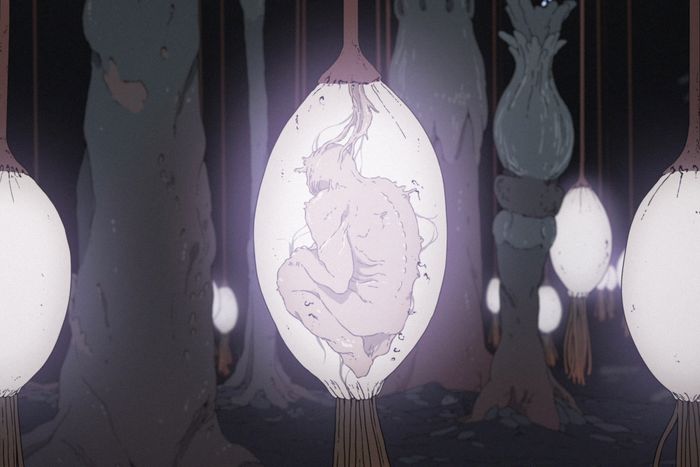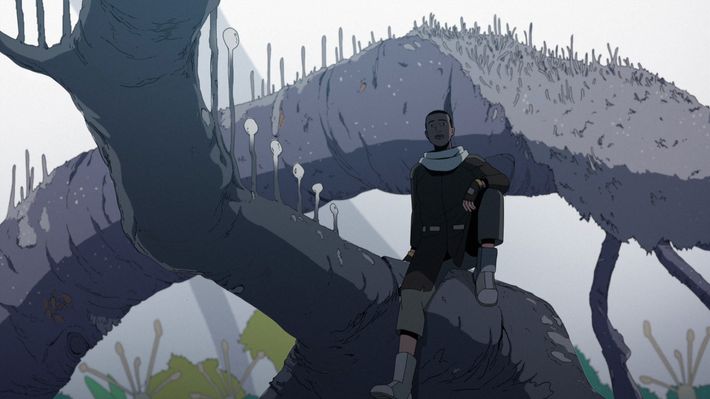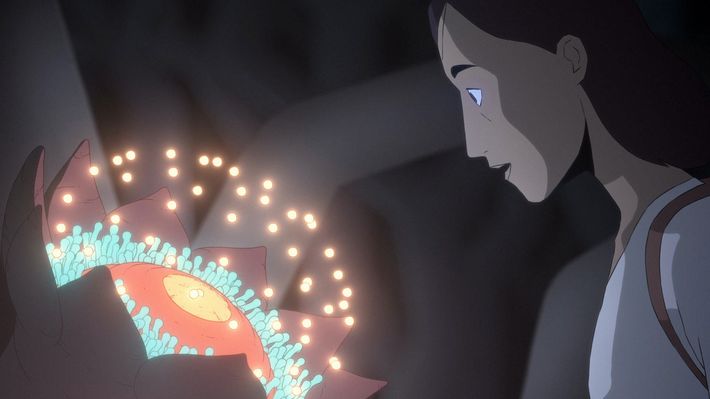
Like a safari from hell, the new Max animated series Scavengers Reign zooms in on nature’s most grotesque biorhythms, vividly imagining what an alien version might look like. Take one seemingly innocuous plant: It pricks and infects a character’s arm before the show jumps into a rendering of its complete life cycle. A deerlike mammal slowly dies from the poison, then explodes into corrosive acid, killing a whole herd while seeding more of the plant that killed them. In Scavengers Reign, humans stumble onto things they don’t understand and pay a heavy toll for their intrusions on a natural world.
Co-created by Joseph Bennett and Charles Huettner, Reign is an expansion of their 2016 short film, Scavengers. The original short was a mystifying depiction of two humans adapting to an outer-space ecosystem, manipulating bizarre alien creatures like instruments. There’s still a resemblance — a similar scene appears early in Reign — but here the alien habitat pushes back against the nonnative visitors.
While the short had an unnerving air about it, it appears downright utopian compared to Scavengers Reign — which is gorgeous but serves up wince-inducing body horror to go with the more existential variety as a group of colonists tries to survive a beautiful but desolate planet. The series begins with the cryogenically frozen crew of the cargo ship Demeter getting marooned on the planet Vesta Minor while en route to a new outer-space colony. In the lean opening title sequence, escape pods jettison to the surface of the planet, and the show picks up with several crew members attempting to survive as they seek the crashed remains of their ship, fellow survivors, and a route off the unfamiliar planet.
Sam and Ursula (voiced by Bob Stephenson and Sunita Mani, respectively), the former a veteran pilot and the latter a botanist, have best adapted to the planet and taken advantage of its unique wildlife. In one scene, an area on the way back to the Demeter has dangerous airborne spores, so Sam and Ursula (rather disgustingly) use a tentacled animal as a makeshift gas mask. In another, they hitch a ride on a sea creature’s egg sac to cross a body of water, before realizing large predatory crustaceans feed on said eggs. They soon find themselves fighting for their lives. Reign isn’t only concerned with wildlife, though, but also with the existential crises that Vesta’s strange habitats incite. Another pair, Azi (Wunmi Mosaku) and her fascinating, rotund robot companion, Levi (Alia Shawkat), confront more ontological questions: The robot journeys to personhood and begins to dream after a mysterious substance grows on its circuit boards, the planet overpowering and altering man-made technology. Levi changes into something else, and keeps changing, more than Azi can anticipate, more than a simple diagnostic can explain.
If Sam, Ursula, Azi, and Levi take a cautious, survivalist approach to navigating Vesta, keeping the natural world at a distance as they work their way toward the Demeter, Kamen (Ted Travelstead) becomes dependent on it. Alone in the wilderness, he meets a freaky four-legged companion that looks halfway between a frog and a bald, gray little man. It rescues him from isolation, but their relationship is transactional, as it forces him into a disturbing, symbiotic bond by making him hallucinate his wife, Solaris style. Kamen begins to hunt other creatures for the organism to consume, allowing it to grow larger and larger in exchange for protection. Like Stanislaw Lem’s famous work, it’s interesting to watch the human mind bend to try and understand a truly alien environment, and upsetting when we see the strain of the attempt. All the while, Scavengers Reign is brutal and violent but most frequently dreamlike and reserved in its dialogue, leaving a lot of room for the viewer to apply meaning to it.
Full of vibrant color and detailed texture in how it depicts Vesta’s ecology, Scavengers Reign looks spectacular, an artist’s impression of the hypnotic brutality and transient beauty of the natural world. It’s also remarkably otherworldly, the designs full of preternatural strangeness. In addition to a high density of weird little guys, Vesta is also populated by almost eldritch monstrosities. The fauna have a vague, recognizable familiarity to their anatomy, animated naturalistically despite their overall alien appearance. But they often defy explanation in other ways, such as how they fit together in this esoteric ecosystem (one of my favorite recurrences: a lilylike flower that only blooms out of the remains of death). This detailed, biologist’s focus on the planet’s natural life is in itself compelling, scenes given breathing room by observations of little creatures going about their business — the planet teeming with complex life in our absence is rather humbling to consider. It’s also utterly fucking gross sometimes, as Bennett and Huettner mix in more tactile, gooey terrors, such as an Akira-esque, hallucinatory moment of Ursula’s guts spilling out onto the floor as hostile flora erupts from her veins.
In other scenes in which Vesta isn’t messy and cruel, it looks uncanny, as so much of it feels constructed by sentient life even though the planet is untouched by humans. As the show moves from parched flatlands to savannas and tropical forests, there are intrusions on familiar scenery, like crystalline rivers or smooth stone structures, some of which pulse and breathe like a living thing. Often, they serve as static obstacles in the crew’s path to their ship, but sometimes the planet changes something unseen within them. In one of my favorite sequences, Ursula walks through an underground cavern with branches that respond to her touch, pulling back to reveal a creature that lives its entire life in front of her, in the blink of an eye. Ursula sheds tears in response, unable to explain to Sam what she just saw. In other scenes, some of the crew’s interactions with nature become like ritual — sometimes soothing, sometimes terrible. Kamen provides plenty of the latter, as he feeds more and more creatures to his spooky gray friend.
Scavengers Reign reflects many of its sci-fi forebears, among them the films and comics that emerged after 2001: A Space Odyssey. The reason the humans are stranded in hostile alien territory in the first place boils down to corporate apathy, echoing Ridley Scott’s Alien or Prometheus (as does a horrific entity incubated in a human ribcage). But the art direction — overseen by Huettner —is Scavengers Reign’s most effective pull, inspired by the artist Jean Giraud’s work in pulp sci-fi and fantasy, mostly under the pseudonym Mœbius. The show’s visual artistry takes cues from his ligne claire drawing style, the frequently arid color palettes of the planet’s surface harkening to the French artist’s attraction to desert landscapes. Many scenes in Scavengers Reign recall his phantasmagorical design work on the 1982 film Time Masters, like in the stony structures that grow like branches and a variety of bizarre bulbous fruit. But as long as Scavengers’s apparent list of influences is, its host of creatures and atmosphere are so bizarre that its identity feels wholly its own. The series’ score underlines the mutability of this ecosystem with a score full of arrhythmic chimes and melodic hums, slightly discordant piano notes, synths, and even panpipes, all as variable as the planet itself, as present for the moments of beauty as they are for those of gruesomeness.
Scavengers Reign’s animated imagination of outlandish cycles of life and habitats free from our tampering is uniquely thrilling. It provokes questions about our own Anthropocene, how people interact with natural environments, what could happen when those environments push back harder than human understanding and technology can compensate for. It’s horrifying and gory, sure, but those provocations never feel misanthropic or empty — more a grim counter to the expansionist impulse that led the crew of the Demeter to the planet in the first place. If anything, Scavengers Reign is bursting with ideas — about how everything undergoes constant change, about the blurry line between tangible and intangible fears, about color direction — that could only be fully expressed through the pen.






